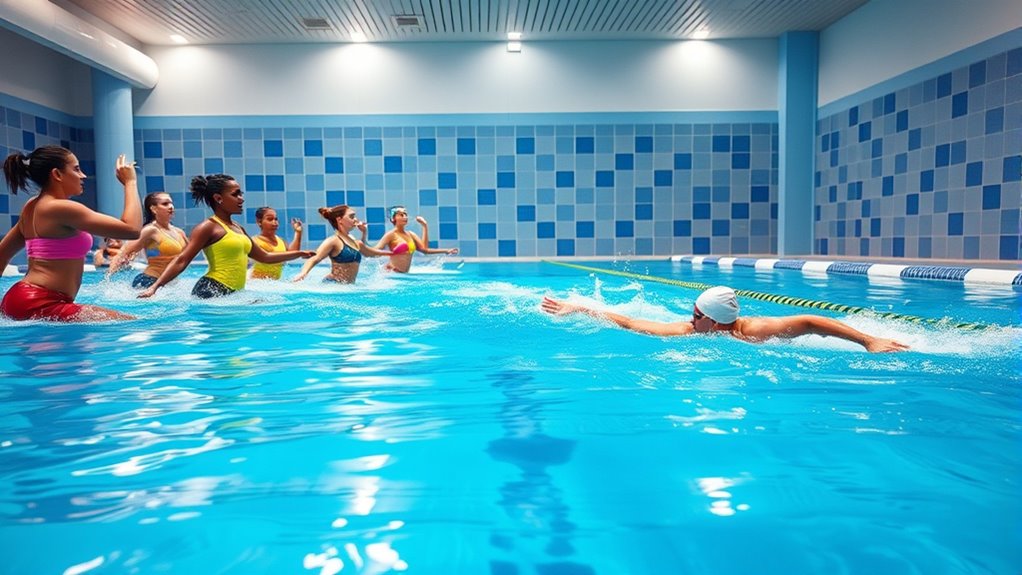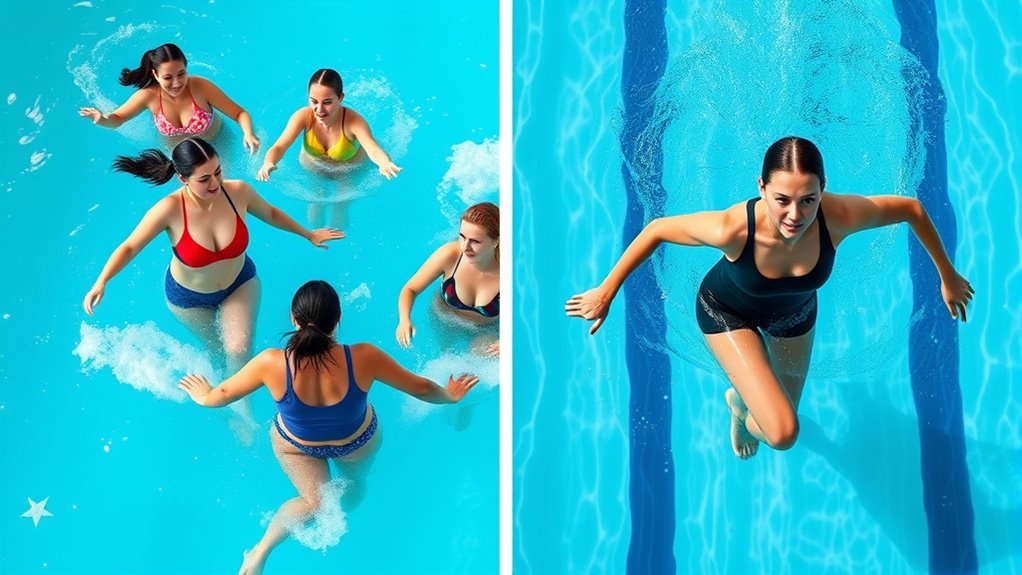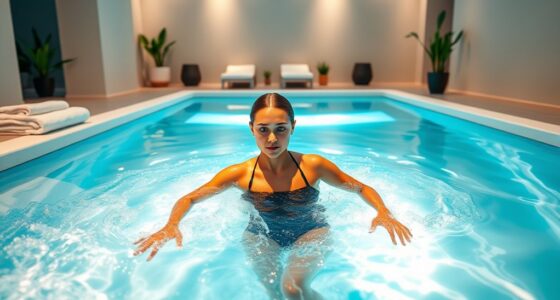Choosing between water aerobics and lap swimming depends on your fitness goals and preferences. Water aerobics offers a fun, social, low-impact workout that improves flexibility and joint mobility, ideal if you prefer group activities or need a gentle exercise. Lap swimming provides an intense cardiovascular workout and builds endurance through repetitive motion, perfect for those seeking a more solitary challenge. Understanding these differences can help you pick the activity that best fits your needs as you learn more.
Key Takeaways
- Water aerobics offers low-impact, joint-friendly exercise ideal for flexibility, recovery, and group motivation; lap swimming emphasizes cardiovascular endurance and stamina.
- Lap swimming typically involves cooler water, increasing calorie burn and intensity, whereas water aerobics often occurs in warmer pools for muscle relaxation.
- Water aerobics is suitable for all ages and mobility levels, providing a social, rhythmic workout; lap swimming is more solitary, focusing on technique and endurance.
- Choosing between them depends on fitness goals: flexibility and recovery favor water aerobics, while cardiovascular health and stamina benefit from lap swimming.
- Both activities support overall fitness, so the better choice aligns with personal preferences, impact tolerance, and specific health or performance objectives.

Are water aerobics and lap swimming truly different ways to stay fit in the pool? The answer depends on what you’re looking for in your workout, but both activities offer unique benefits. Water aerobics is often associated with hydrotherapy benefits, making it a popular choice for those recovering from injury or seeking low-impact exercise. The gentle resistance of water helps improve flexibility and joint mobility without putting excessive strain on your body. When you participate in water aerobics, you’re not just working out your muscles—you’re also promoting circulation and reducing inflammation, which can accelerate recovery and enhance overall well-being.
Water aerobics promotes flexibility, joint mobility, circulation, and recovery with gentle water resistance.
On the other hand, lap swimming is a more structured and vigorous activity that targets cardiovascular health and muscular endurance. While it’s excellent for building stamina, it also comes with water temperature effects that influence your workout. Typically, pools used for lap swimming are kept cooler, around 78-82°F, which helps you stay alert and prevents overheating during extended sessions. Cooler water can increase your calorie burn slightly because your body works harder to maintain its core temperature. Conversely, warmer pools, often used for water aerobics, can make your workout feel more relaxing and may help loosen stiff muscles, especially if you’re dealing with arthritis or mobility issues.
Your choice between water aerobics and lap swimming should consider these water temperature effects, as they can impact your comfort and performance. If you prefer a workout that’s easy on your joints and offers a social, energetic atmosphere, water aerobics is a great option. It combines rhythmic movements and often incorporates music, making exercise feel less like a chore. Plus, since it’s low-impact, it’s accessible to people of all ages and fitness levels.
If your goal is to boost endurance, challenge yourself with longer laps, or improve your swimming technique, then lap swimming might be better. It demands more from your cardiovascular system and engages multiple muscle groups simultaneously. The consistent, repetitive motion can also improve your mental focus and discipline. While both activities are effective, your preference might hinge on how much impact you want, whether you enjoy group classes or solo workouts, and the temperature of the pool environment. Additionally, understanding the benefits of water-based exercise can help you make an informed decision to meet your specific health needs. In the end, both water aerobics and lap swimming can contribute considerably to your fitness goals, making the decision a matter of personal preference and specific health needs.
Frequently Asked Questions
Can Water Aerobics Help Improve Joint Flexibility More Than Lap Swimming?
You might wonder if water aerobics can boost joint mobility more than lap swimming. Water aerobics focuses on low-impact, dynamic movements that encourage flexibility enhancement, making it easier to improve joint mobility without strain. While lap swimming provides excellent overall fitness, the varied, weight-bearing exercises in water aerobics specifically target flexibility. So, if your goal is to enhance joint flexibility, water aerobics could be more beneficial.
Which Workout Burns More Calories in a Shorter Time?
When comparing calorie burn in a short time, lap swimming generally wins for workout efficiency. You burn more calories faster because it’s a high-intensity activity that engages your entire body. Water aerobics, while excellent for joint health and flexibility, tends to burn fewer calories in the same period. If your goal is maximum calorie burn quickly, lap swimming is the better choice for efficient, intense exercise.
Are Water Aerobics Suitable for People With Chronic Injuries?
Think of your body as a delicate boat steering through choppy waters. Water aerobics acts like a gentle tide, making it perfect for injury rehabilitation and those with chronic injuries. It’s a low impact exercise that reduces strain while still providing effective movement. If you’re dealing with persistent pain or damage, water aerobics offers a safe, supportive environment to stay active without risking further injury.
How Does the Social Aspect Differ Between Water Aerobics and Lap Swimming?
You’ll notice that water aerobics offers a lively social scene with group dynamics and instructor interaction, making it easy to connect and stay motivated. In contrast, lap swimming tends to be more solitary, allowing you to focus on your workout without much social engagement. If socializing boosts your motivation, water aerobics provides a more interactive environment. Otherwise, lap swimming offers peaceful solitude for personal focus.
Is There a Significant Difference in Accessibility Between the Two Activities?
Imagine you want to start water exercise but face accessibility challenges due to limited pool access in your area. Generally, water aerobics offers easier entry since it often requires less equipment and can be done in shallow water, whereas lap swimming might need a larger, well-equipped pool. Equipment requirements and pool availability influence accessibility, making water aerobics more accessible for many beginners or those with mobility issues.
Conclusion
Ultimately, both water aerobics and lap swimming boost your fitness, so choose what keeps you motivated. Water aerobics offers social fun and easier impact, while lap swimming provides a more intense workout. Remember, “A journey of a thousand miles begins with a single step,” so start today and enjoy the benefits of your chosen activity. Consistency is key—find what you enjoy and stick with it for lasting health and vigor.









